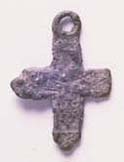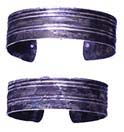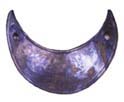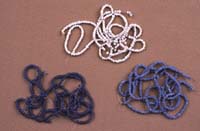
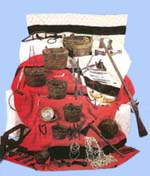 |
European trade goods commonly provided to American Indians in exchange for furs and hides. |
The Illinois . . . repair to this place [Lake Superior] from time to time in great numbers, as Merchants, to carry away hatchets and kettles, guns, and other articles that they need. (Claude Dablon, 1669)![]()
The traditional technology of the Illinois was well-suited to their semi-sedentary way of life based on hunting, gathering, and agriculture. But their world changed forever in the 1600s, when European trade goods were made available to them at French trading posts. Some items, such as guns and gunpowder, became crucial to their very existence. The Illinois were being threatened at that time by well-armed Iroquois war parties, and they needed European weapons to defend their territory. Despite the increasing importance of firearms, the Illinois continued to use bows and arrows well into the 1700s.
![]()
Some European trade goods, while not critical to the tribe's survival, were adopted by the Illinois because they offered a perceived advantage over traditional objects. For example, brass kettles probably became desirable trade items because they were more durable and easier to carry than fragile earthen pots. Also, kettles had value even after they wore out and could no longer be used as containers. The Illinois cut up their old kettles to make brass arrowheads, tinkling cones, and beads.
![]()
Brass kettle from the Jamestown site, Illinois (c1700-1765).
Iron knife with bone handle from the Waterman site, a Michigamea Illinois village (1752-1765)
Other metal trade goods replaced traditional objects made of stone, bone, and shell. For example, iron knives replaced knives made of chipped stone; iron ax-heads replaced celts made of ground stone; and iron hoe blades replaced blades made of mussel shell. In each of these examples, the iron tool was desirable because it had a longer use-life and was easier to maintain than the traditional tool.
1. Lead cross from the Guebert site, a Kaskaskia Illinois village (1719-1765)
1
The Illinois also incorporated trade goods in their clothing and ornaments. For example, cloth garments began to replace traditional leather clothing in the late 1600s. Glass beads also became popular, replacing the decorative quillwork that had traditionally been applied to moccasins and headbands. Other ornaments obtained from the French include brass bells, brass rings, lead crosses, silver bracelets and silver gorgets.
![]()
2. Silver bracelets from the Waterman site
3. Crescent-shaped engraved silver gorget from the Waterman site
4. Glass trade beads from the River L'Abbe Mission site, a Cahokia Illinois village (1735-1753)
2![]()
3![]()
4
|
|
Copyright © 2000 Illinois State Museum


